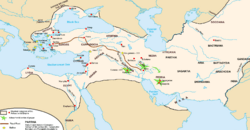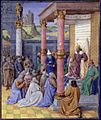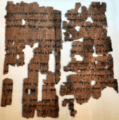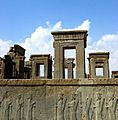Achaemenid Empire facts for kids
 Achaemenid Empire. |
|
| Vexilloid | The vexilloid of the Achaemenid Empire was a gold falcon on a field of crimson. |
|---|---|
| Languages | Persian, Elamite, Aramaic, Hebrew |
| Religions | There was no official state religion. Zoroastrianism was practiced by the nobility but limited to them; numerous other religions, such as Judaism, were practiced. |
| Capitals | Anshan, Ecbatana, Pasargadae, Persepolis, Susa |
| Area | Near East, Central Asia, Western South Asia, North Africa, and Southeast Europe |
| Existed | 550-330 BCE |
The Achaemenid Empire, also known as the Achaemenid Persian Empire, was a huge and powerful empire that existed from 550 to 330 BCE. It was the first of the great Persian Empires. This empire took over from the Median Empire and became the second major empire of the Iranian people.
At its peak, the Achaemenid Empire covered about 7.5 million square kilometers. This made it the largest empire of its time in classical antiquity. It stretched across three continents!
Contents
Rise of the Achaemenid Empire
Cyrus the Great: The Founder
The Achaemenid Empire was started by a famous leader named Cyrus the Great. He was a brilliant military leader and a smart ruler. Cyrus began by conquering the Median Empire, which the Achaemenids had been a part of. He then expanded his new empire greatly.
Where the Empire Stretched
The empire grew to include many different lands. It covered parts of Afghanistan and Pakistan. It also included areas in Central Asia, Asia Minor (modern-day Turkey), and Thrace. Much of the Black Sea coast was under its control. The empire also ruled over Iraq, northern Saudi Arabia, Jordan, Israel, Lebanon, and Syria. Even ancient Egypt and parts of Libya in North Africa were part of this vast empire.
Life in the Achaemenid Empire
Languages and Culture
The Achaemenid Empire was very diverse. Many languages were spoken across its lands. Persian was important, but Aramaic became the official language for communication across the empire. This helped different parts of the empire talk to each other.
Religious Freedom
The Achaemenids were known for allowing people to practice their own religions. There was no single official state religion. While Zoroastrianism was common among the nobles, many other religions, like Judaism, were also practiced freely. For example, Cyrus the Great famously allowed the Israelites to return home from their Babylonian captivity.
Lasting Influence
Because the empire was so large and lasted for a long time, it had a huge impact on the world. Its influence can still be seen today in language, religion, building styles, ideas about life, laws, and how governments are run in many countries.
Key Conflicts and Decline
Wars with Ancient Greece
The Achaemenid Empire often clashed with the Greek city-states. These conflicts are known as the Greco-Persian Wars. Under King Xerxes, the Achaemenids came very close to conquering Ancient Greece. However, the Greeks managed to defend their lands.
Conquest by Alexander the Great
The Achaemenid Empire eventually came to an end. It was overthrown by Alexander the Great in 330 BCE. Alexander's conquests marked the end of this powerful Persian empire.
See Also
- Persian Empire
- Cyrus the Great, Founder of Achaemenid dynasty and King of Persia.
- Darius I, King of Persia.
- Sassanid Empire
 In Spanish: Imperio aqueménida para niños
In Spanish: Imperio aqueménida para niños
Images for kids
-
Cyrus the Great is said, in the Bible, to have liberated the Hebrew captives in Babylon to resettle and rebuild Jerusalem, earning him an honored place in Judaism.
-
The tomb of Cyrus the Great, founder of the Achaemenid Empire. At Pasargadae, Iran.
-
The Persian queen Atossa, daughter of Cyrus the Great, sister-wife of Cambyses II, Darius the Great's wife, and mother of Xerxes the Great
-
Achaemenid gold ornaments, Brooklyn Museum
-
Relief showing Darius I offering lettuces to the Egyptian deity Amun-Ra Kamutef, Temple of Hibis
-
The Battle of Issus, between Alexander the Great on horseback to the left, and Darius III in the chariot to the right, represented in a Pompeii mosaic dated 1st century BC – Naples National Archaeological Museum
-
Relief of throne-bearing soldiers in their native clothing at the tomb of Xerxes I, demonstrating the satrapies under his rule.
-
Seal of Darius the Great hunting in a chariot, reading "I am Darius, the Great King" in Old Persian (𐎠𐎭𐎶𐏐𐎭𐎠𐎼𐎹𐎺𐎢𐏁𐎴 𐏋, "adam Dārayavaʰuš xšāyaθiya"), as well as in Elamite and Babylonian. The word "great" only appears in Babylonian. British Museum.
-
Reconstitution of Persian landing ships at the Battle of Marathon.
-
Greek ships against Achaemenid ships at the Battle of Salamis.
-
A section of the Old Persian part of the trilingual Behistun inscription. Other versions are in Babylonian and Elamite.
-
A copy of the Behistun inscription in Aramaic on a papyrus. Aramaic was the lingua franca of the empire.
-
Bas-relief of Farvahar at Persepolis
-
Tomb of Artaxerxes III in Persepolis
-
The Mausoleum at Halicarnassus, one of the Seven wonders of the ancient world, was built by Greek architects for the local Persian satrap of Caria, Mausolus (Scale model)
-
Reconstruction of the Palace of Darius at Susa. The palace served as a model for Persepolis.
-
Lion on a decorative panel from Darius I the Great's palace, Louvre
-
Iconic relief of lion and bull fighting, Apadana of Persepolis
-
Achaemenid golden bowl with lioness imagery of Mazandaran, National Museum of Iran
-
Ruins of Throne Hall, Persepolis
-
Lateral view of tomb of Cambyses II, Pasargadae, Iran







































